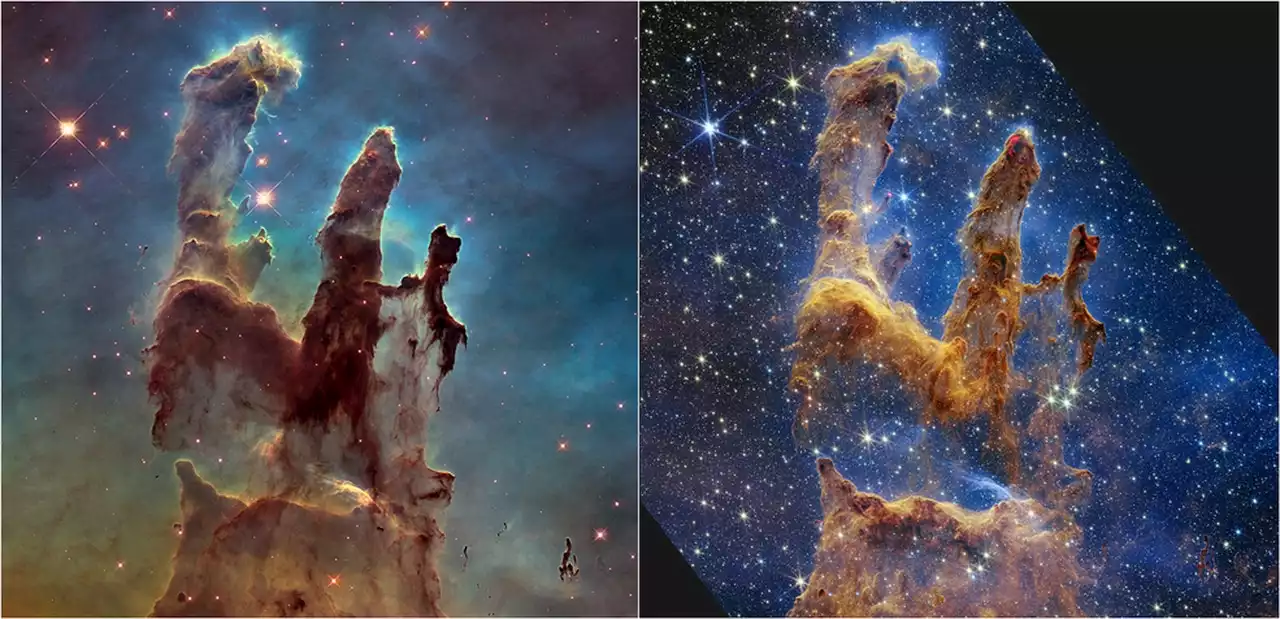The Webb telescope’s mirrors were made in Alabama and assembled and tested for cold resistance at NASA’s Marshall Space Flight Center in Huntsville.
NASA's Hubble Space Telescope made the Pillars of Creation famous with its first image in 1995, but revisited the scene in 2014 to reveal a sharper, wider view in visible light, shown above at left. A new, near-infrared-light view from NASA’s James Webb Space Telescope, at right, helps us peer through more of the dust in this star-forming region. The thick, dusty brown pillars are no longer as opaque and many more red stars that are still forming come into view.
First photographed by NASA’s Hubble Space Telescope in 1995, the pillars are seen much more clearly in the new Webb image. The new images also allow a better count of newly formed stars and the amounts of gas and dust. Here are some things to look and thinks about for in the new image: 1. The “scene stealers,” as NASA calls them, are the bright red orbs, often with “spikes” that lie outside one of the pillars. These orbs eventually collapse under their own gravity becoming new stars.
2. The “wavy lines that look like lava at the edges of some pillars” are ejections from the still-forming stars. Young stars can shoot jets of dust and gas that can collide with the pillars creating bow-shaped waves similar to those a boat makes while moving through the water. The red glow comes from “energetic” hydrogen.4. We are not seeing “through” the clouds at vast distances of space or new galaxies.
If you purchase a product or register for an account through one of the links on our site, we may receive compensation.
United States Latest News, United States Headlines
Similar News:You can also read news stories similar to this one that we have collected from other news sources.
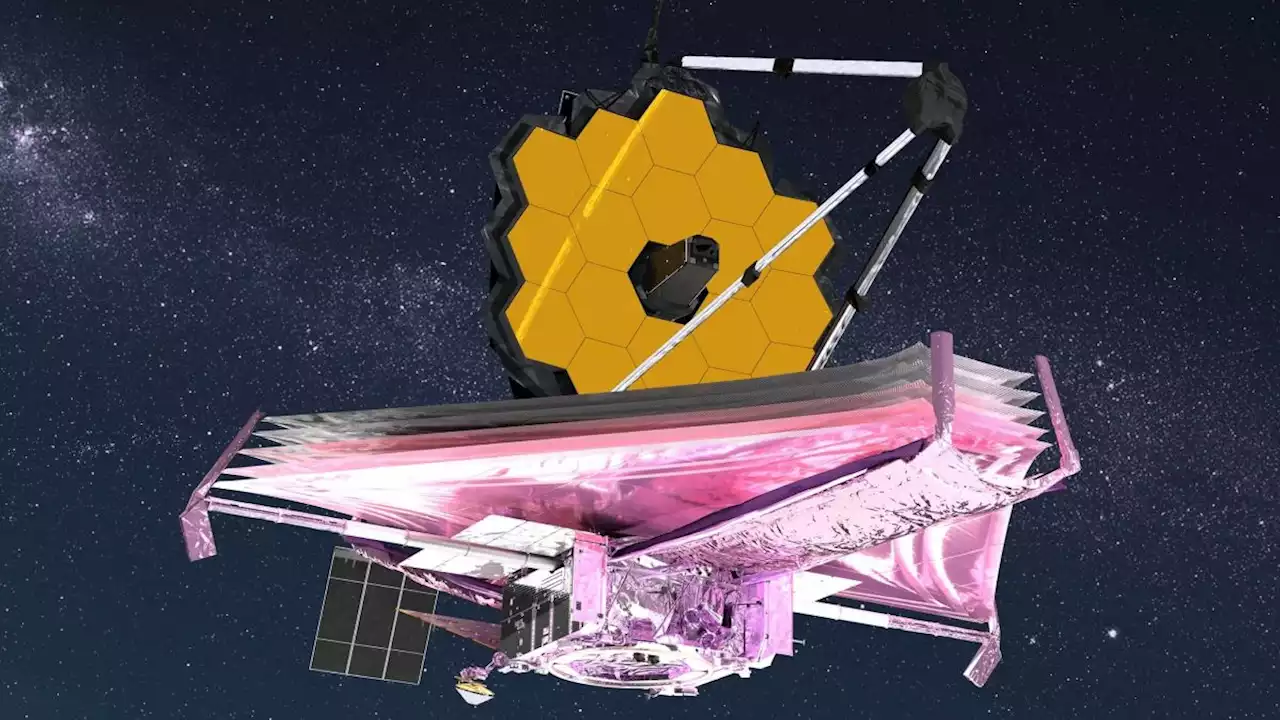 James Webb Space Telescope's 1st year in space has blown astronomers awayKeith Cooper is a freelance science journalist and editor in the United Kingdom, and has a degree in physics and astrophysics from the University of Manchester. He's the author of 'The Contact Paradox: Challenging Our Assumptions in the Search for Extraterrestrial Intelligence' (Bloomsbury Sigma, 2020) and has written articles on astronomy, space, physics and astrobiology for a multitude of magazines and websites.
James Webb Space Telescope's 1st year in space has blown astronomers awayKeith Cooper is a freelance science journalist and editor in the United Kingdom, and has a degree in physics and astrophysics from the University of Manchester. He's the author of 'The Contact Paradox: Challenging Our Assumptions in the Search for Extraterrestrial Intelligence' (Bloomsbury Sigma, 2020) and has written articles on astronomy, space, physics and astrobiology for a multitude of magazines and websites.
Read more »
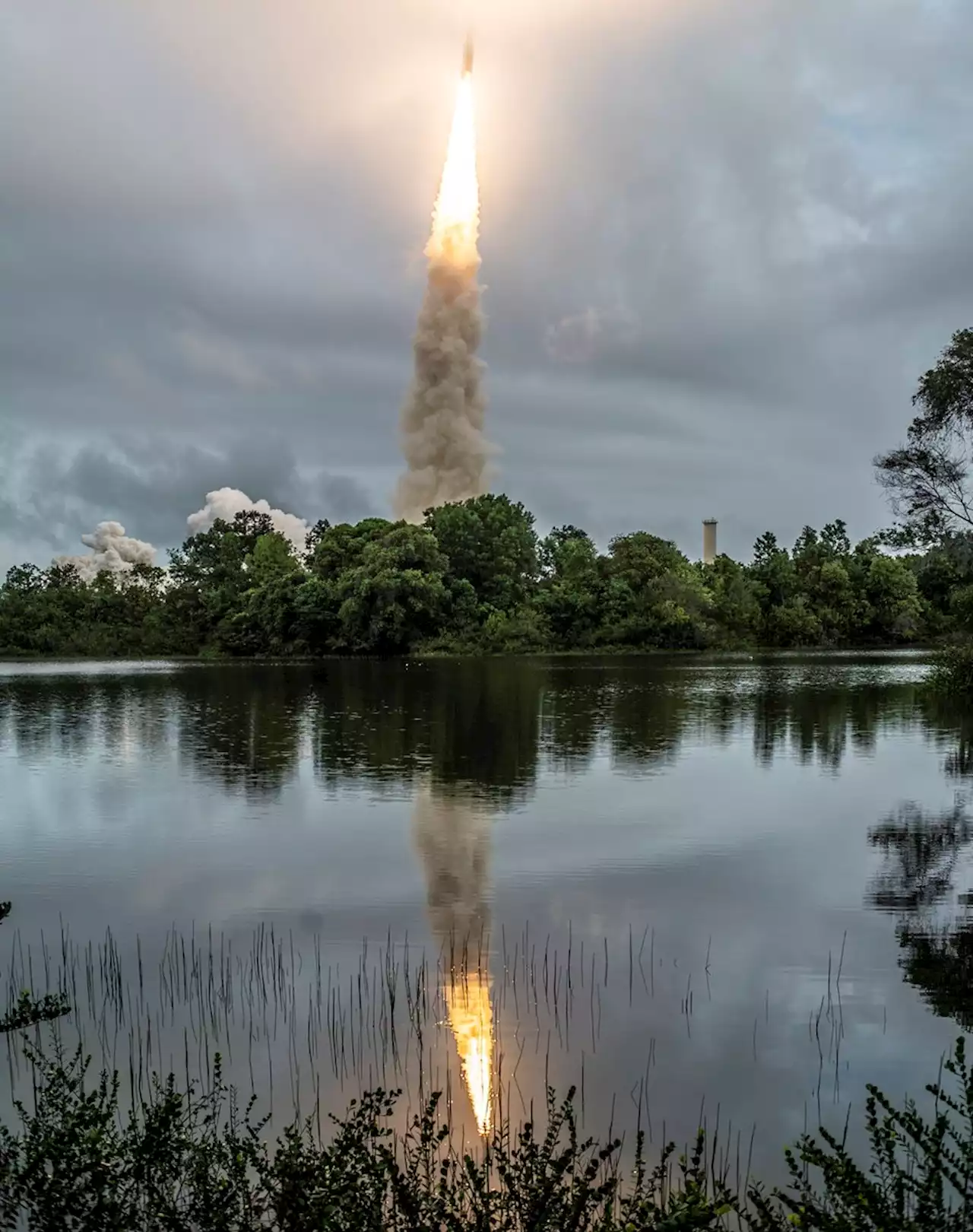 Webb Image Release- Webb Space Telescope GSFC/NASAThe Latest NASA Released Webb Image is featured on this page. The James Webb Space Telescope's revolutionary technology will study every phase of cosmic history—from within our solar system to the most distant observable galaxies in the early universe. Webb’s infrared telescope will explore a wide range of science questions to help us understand the origins of the universe and our place in it. Seeking Light from the First Galaxies in the Universe Webb will directly observe a part of space and time never seen before. Webb will gaze into the epoch when the very first stars and galaxies formed, over 13.5 billion years ago. Ultraviolet and visible light emitted by the very first luminous objects has been stretched or 'redshifted' by the universe's continual expansion and arrives today as infrared light. Webb is designed to “see” this infrared light with unprecedented resolution and sensitivity. Exploring Distant Worlds and the Solar System Webb will also be a powerful tool for studying the nearby universe. Scientists will use Webb to study planets and other bodies in our solar system to determine their origin and evolution and compare them with exoplanets, planets that orbit other stars. Webb will also observe exoplanets located in their stars’ habitable zones, the regions where a planet could harbor liquid water on its surface, and can determine if and where signatures of habitability may be present. Using a technique called transmission spectroscopy, the observatory will examine starlight filtered through planetary atmospheres to learn about their chemical compositions.
Webb Image Release- Webb Space Telescope GSFC/NASAThe Latest NASA Released Webb Image is featured on this page. The James Webb Space Telescope's revolutionary technology will study every phase of cosmic history—from within our solar system to the most distant observable galaxies in the early universe. Webb’s infrared telescope will explore a wide range of science questions to help us understand the origins of the universe and our place in it. Seeking Light from the First Galaxies in the Universe Webb will directly observe a part of space and time never seen before. Webb will gaze into the epoch when the very first stars and galaxies formed, over 13.5 billion years ago. Ultraviolet and visible light emitted by the very first luminous objects has been stretched or 'redshifted' by the universe's continual expansion and arrives today as infrared light. Webb is designed to “see” this infrared light with unprecedented resolution and sensitivity. Exploring Distant Worlds and the Solar System Webb will also be a powerful tool for studying the nearby universe. Scientists will use Webb to study planets and other bodies in our solar system to determine their origin and evolution and compare them with exoplanets, planets that orbit other stars. Webb will also observe exoplanets located in their stars’ habitable zones, the regions where a planet could harbor liquid water on its surface, and can determine if and where signatures of habitability may be present. Using a technique called transmission spectroscopy, the observatory will examine starlight filtered through planetary atmospheres to learn about their chemical compositions.
Read more »
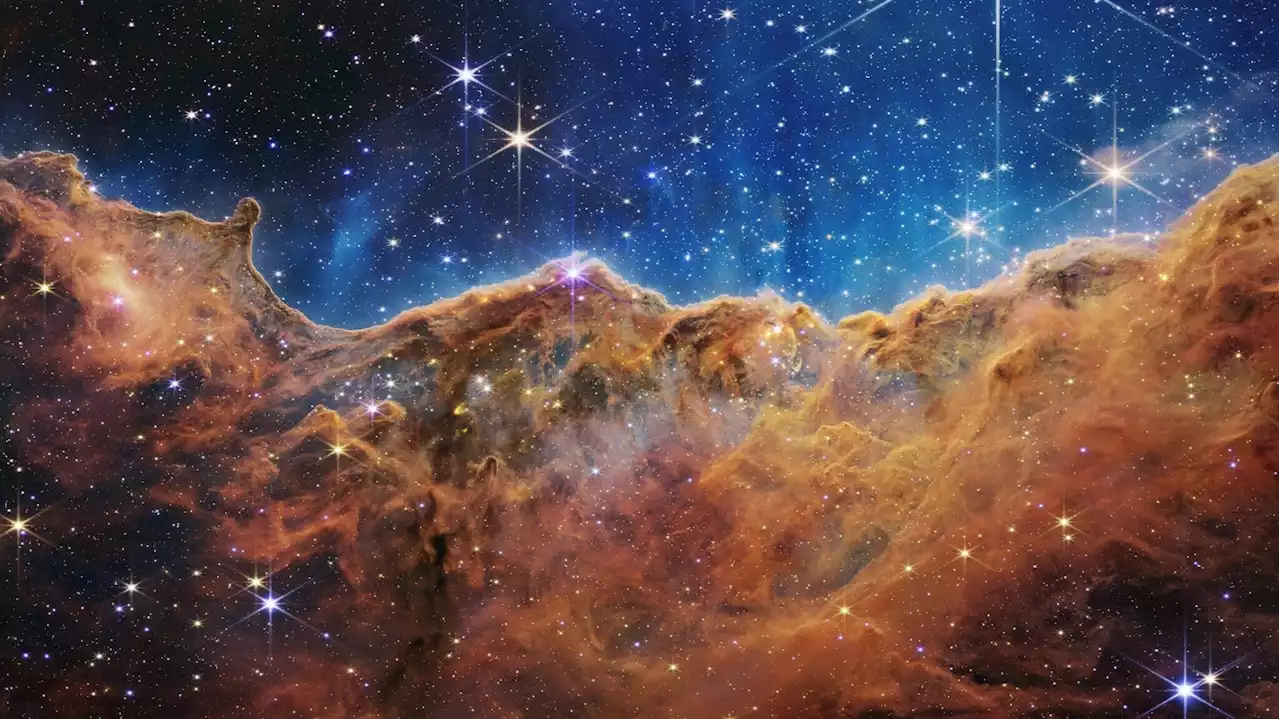 How the James Webb Space Telescope transformed astronomy this yearOne year ago, on Christmas Day, the James Webb Space Telescope was launched. Since it began collecting data, it has captured - in stunning detail - previously unobservable stars, planets and galaxies.
How the James Webb Space Telescope transformed astronomy this yearOne year ago, on Christmas Day, the James Webb Space Telescope was launched. Since it began collecting data, it has captured - in stunning detail - previously unobservable stars, planets and galaxies.
Read more »
 10 incredible James Webb Space Telescope images reveal the wonders of the universeThe Hubble telescope continues to be a great scientific instrument and can see at optical wavelengths where the JWST cannot. But the Webb telescope can see much further into the infrared with greater sensitivity and sharpness.
10 incredible James Webb Space Telescope images reveal the wonders of the universeThe Hubble telescope continues to be a great scientific instrument and can see at optical wavelengths where the JWST cannot. But the Webb telescope can see much further into the infrared with greater sensitivity and sharpness.
Read more »
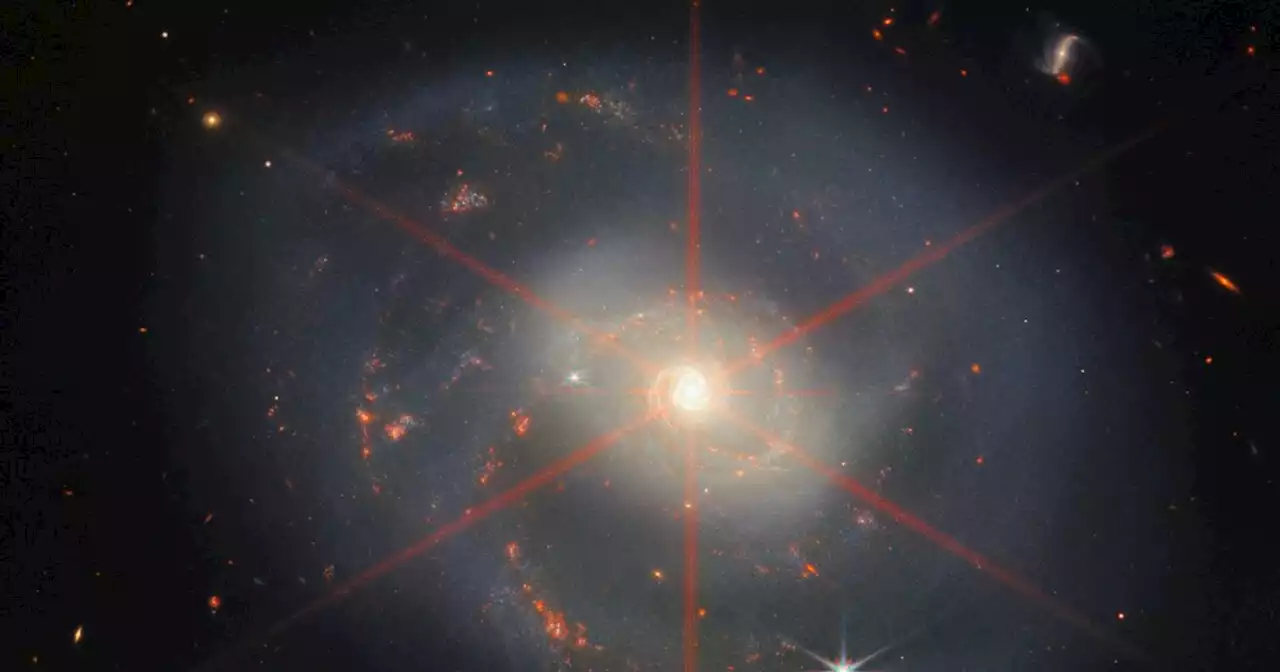 James Webb image shows the bright glowing heart of a galaxy | Digital TrendsAstronomers recently shared a stunning new image of space from the James Webb Space Telescope, showing a galaxy with an unusually bright heart.
James Webb image shows the bright glowing heart of a galaxy | Digital TrendsAstronomers recently shared a stunning new image of space from the James Webb Space Telescope, showing a galaxy with an unusually bright heart.
Read more »
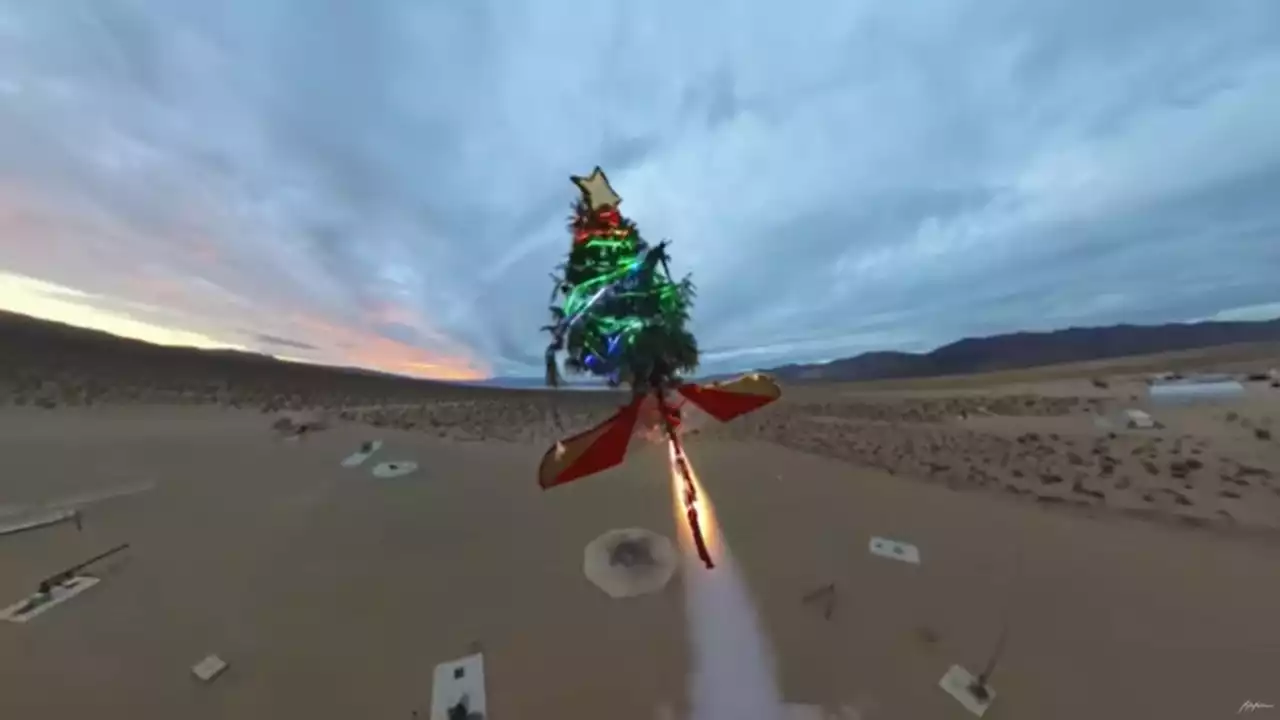 Watch an epic Christmas tree launch for the holidays by DIY 'Rocket-tree' makers (videos)Tariq is the Editor-in-Chief of Space.com and joined the team in 2001, first as an intern and staff writer, and later as an editor. He covers human spaceflight, exploration and space science, as well as skywatching and entertainment. He became Space.com's Managing Editor in 2009 and Editor-in-Chief in 2019. Before joining Space.com, Tariq was a staff reporter for The Los Angeles Times covering education and city beats in La Habra, Fullerton and Huntington Beach. In October 2022, Tariq received the Harry Kolcum Award for excellence in space reporting from the National Space Club Florida Committee. He is also an Eagle Scout (yes, he has the Space Exploration merit badge) and went to Space Camp four times as a kid and a fifth time as an adult. He has journalism degrees from the University of Southern California and New York University. You can find Tariq at Space.com and as the co-host to the This Week In Space podcast with space historian Rod Pyle on the TWiT network. To see his latest project, you can follow Tariq on Twitter tariqjmalik.
Watch an epic Christmas tree launch for the holidays by DIY 'Rocket-tree' makers (videos)Tariq is the Editor-in-Chief of Space.com and joined the team in 2001, first as an intern and staff writer, and later as an editor. He covers human spaceflight, exploration and space science, as well as skywatching and entertainment. He became Space.com's Managing Editor in 2009 and Editor-in-Chief in 2019. Before joining Space.com, Tariq was a staff reporter for The Los Angeles Times covering education and city beats in La Habra, Fullerton and Huntington Beach. In October 2022, Tariq received the Harry Kolcum Award for excellence in space reporting from the National Space Club Florida Committee. He is also an Eagle Scout (yes, he has the Space Exploration merit badge) and went to Space Camp four times as a kid and a fifth time as an adult. He has journalism degrees from the University of Southern California and New York University. You can find Tariq at Space.com and as the co-host to the This Week In Space podcast with space historian Rod Pyle on the TWiT network. To see his latest project, you can follow Tariq on Twitter tariqjmalik.
Read more »
